Social Centers for an Emerging Town
Introduction
Text-to-speech Audio
Cross at the light over to the north side of Main Street for a close-up view of Sun Prairie’s “Old City Hall.”
Built in 1895, the hall was a significant municipal achievement for the small but growing community. Located in the center of Sun Prairie’s downtown, the building’s first floor included a council room, jail, vault and two rear bays serving as engine house storage for the local fire department, with a 1000-gallon cistern of water storage in the basement below. The second floor's open hall ran the full length of the building and was used for dances, operas, agricultural shows and other community centered events. The building is capped by 65’ tall tower that held the community’s fire bell. The city moved to a new municipal building in 1956 and the “Old City Hall” passed to private ownership, with commercial use on the first floor and apartment residences above.
From the corner of the Old City Hall, look back to the south across Main Street.
The Queen Anne style building on the corner was the Hotel Kleiner built in 1896, the town's first new hotel in over 25 years. A large “Citizen’s Benefit Banquet” was held on February 3, 1897, in honor of the formal opening of the hostelry with over 100 people attending. A hint of the pride and class of the new hotel was captured in the newspaper report of the time; “as each person was ushered in, they were given a bouquet of roses, as everything down to the minutest detail was arranged for the perfect enjoyment of the guests. Music and singing of a high order was rendered to while away the time until dinner was announced”.[1]
After “a feast fit for the Olympian gods” a formal program of speeches was held. Most interesting for the modern observer was a speech entitled “Sun Prairie and Hotel Kleiner in 1997,” outlining predictions for the future 100 years after the night of the banquet. Although the renaming of Main Street as “Wonder Street” was a bit off, visions of Sun Prairie having grown 5 times its original size with airships, clear flowing water from wells and even a type of solar panel were described and turned out to be relatively accurate.[2]
Scroll down for more detail on these buildings.
Images
City Hall with first tower, ca. 1906. SPHLM #P8624.20
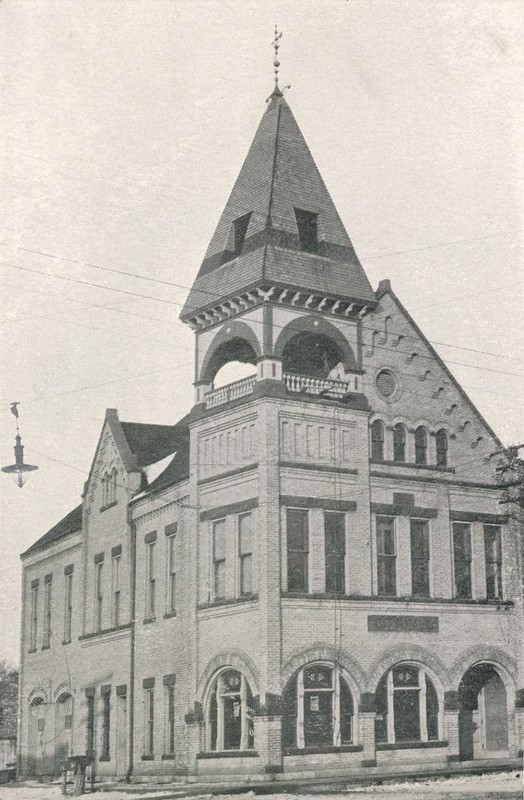
City Hall with second tower, ca. 1913. SPHLM #P76104
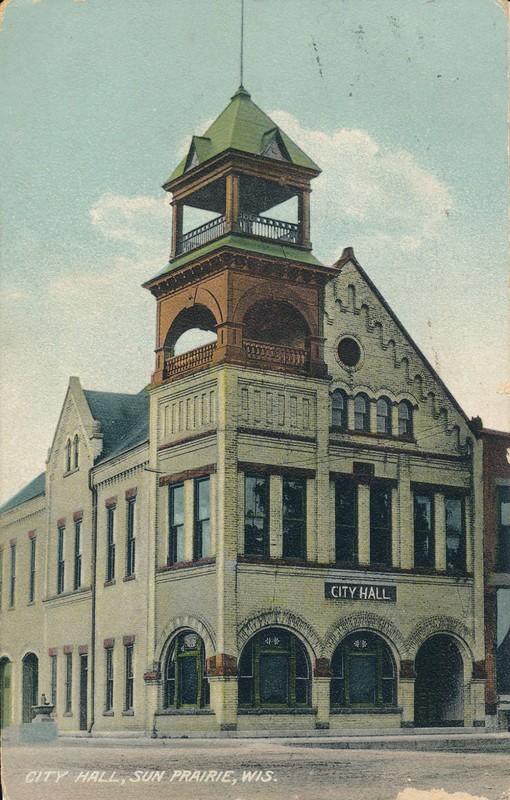
Main Street facing east, ca. 1915. SPHLM #P222408
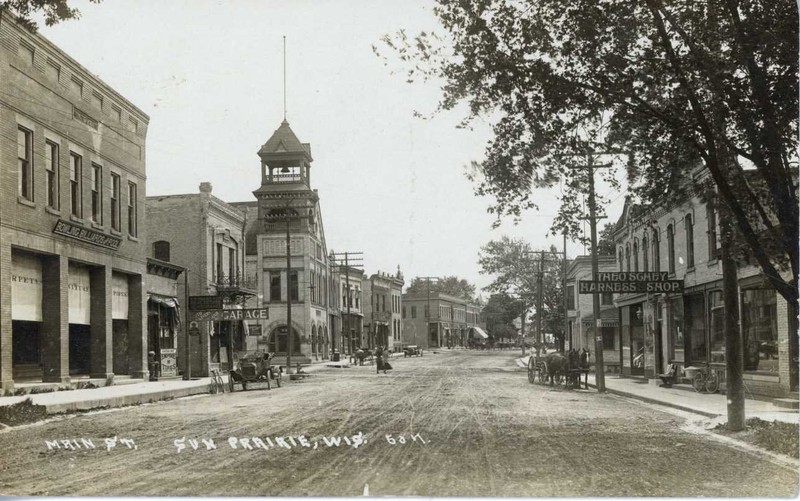
Bird's Eye View of Sun Prairie, Wis., ca. 1911. SPHLM #M07543
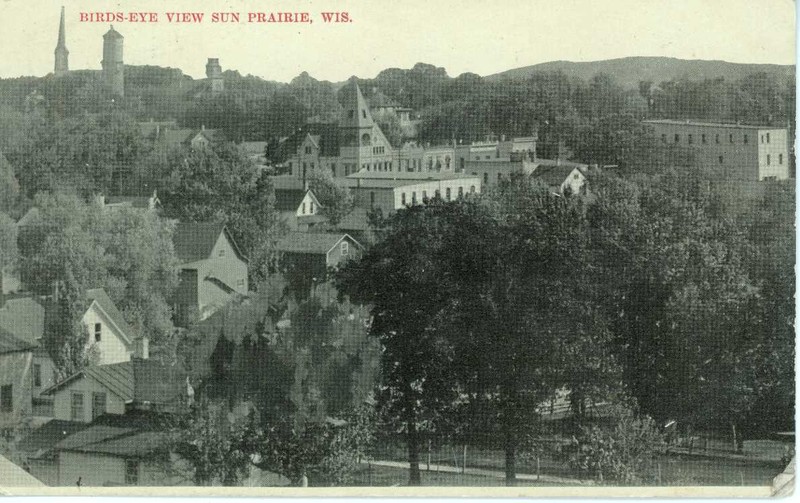
2023 Image of original 1892 fire bell located at Angell Park
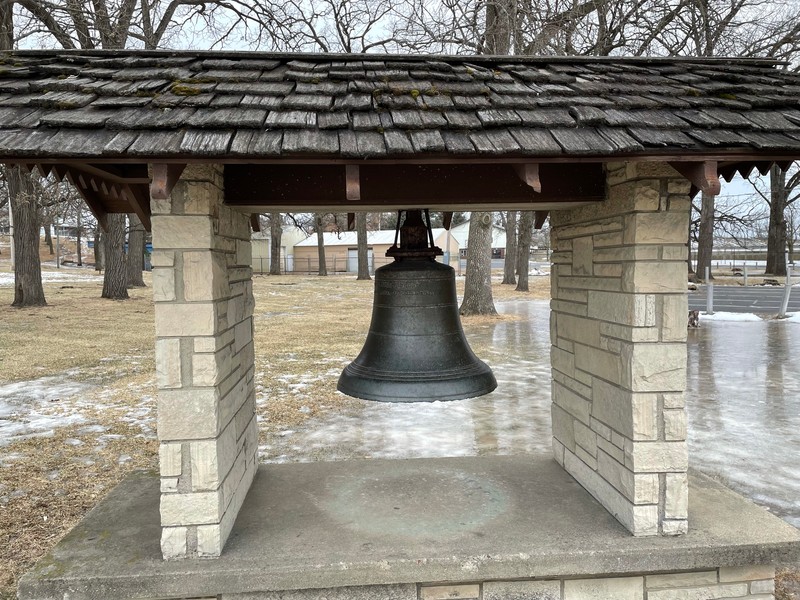
Hotel Greene, ca. 1904. SPHLM #P8624-47
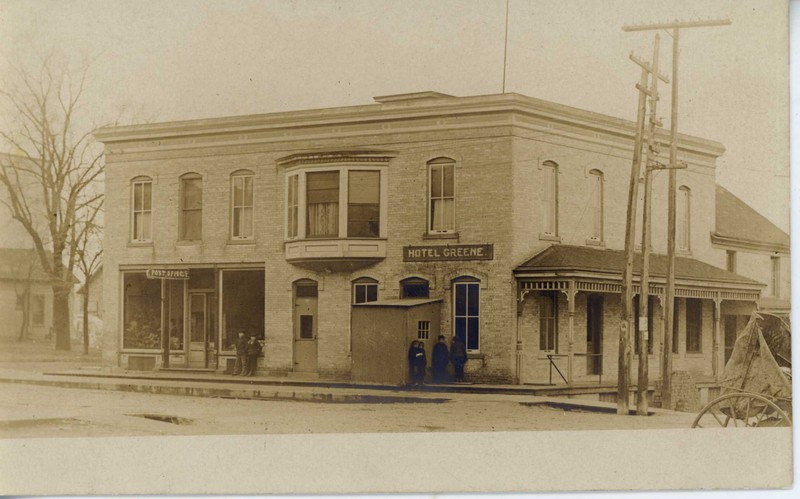
Robinson & Belda Real Estate and Insurance, ca. 1980s. SPHLM #P971224
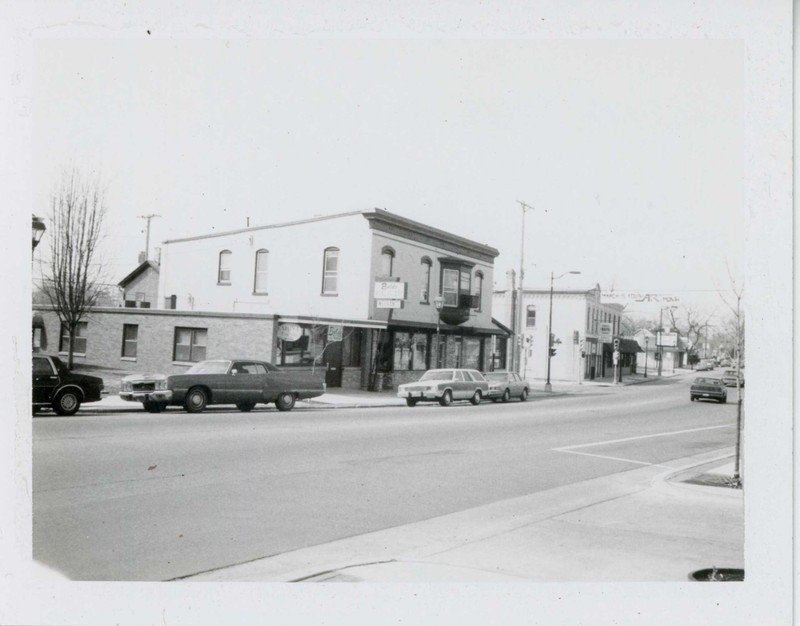
Belda Real Estate and Main 1 Hair Salon, ca. 1980s. SPHLM #P232255 (retouched)

Backstory and Context
Text-to-speech Audio
100 E. Main
Historic Name: Sun Prairie City Hall
Constructed: 1895
2024 Business: This address is not in use as a commercial business as of 2024.
The Sun Prairie City Hall served as a social center for the growing community. The first floor included a village council meeting room, jail, and two rear bays of engine storage for the local fire department, with a 1000-gallon cistern of water in the basement. The jail windows and firehouse bays are still visible on the west side of the building.
The open hall on the second floor was used for dances, operas, agricultural shows, lectures, concerts, graduations, and other community events. The hall also served as a gymnasium for winter sports including an indoor baseball club.
The building is capped by a 65 foot tower that had a rope hanging down to the sidewalk so that anyone could alert the village to a fire. The first tower was replaced in 1911 after being struck by lightning and the bell now sits in a monument at Angell Park.
Sun Prairie moved to a new municipal building in 1956 and the “Old City Hall” passed to a private owner. Since Sun Prairie was not incorporated as a city until 1958, the building was never truly a City Hall.
101-105 E. Main
Historic Name: Hotel Kleiner
Constructed: 1896
2024 Businesses: The Opti-Mystic, Abarrotes El Primo Taqueria. The Nail Boutique operates in the building at
107 S. Bristol Street.
Hotel Kleiner was built in 1896 and was welcomed as the first new hotel established within the growing town of Sun Prairie in over 25 years. By 1904 the building was known as Hotel Greene and was later named the Commercial Hotel. The building housed the Sun Prairie Post Office until a stand-alone building was constructed on Main Street in 1910. In 1936, it was purchased by Esther and Frank Hebl who continued its use as a hotel and later a rooming house. Today the building hosts businesses in its street level commercial space and private apartments in its upper floors.
109 E. Main
Historic Name: Robinson & Belda Building
Constructed: 1958
2024 Business: Sun Prairie Chamber of Commerce
To the left of the Hotel Kleiner is the youngest building in Sun Prairie’s Downtown Historic District originally constructed for the Robinson & Belda Real Estate and Insurance office. The current structure replaced the last metal-sided building in the district – an 18’ x 26’ building of galvanized steel erected in 1927 by the S.E. Beers Insurance Agency.[3]
Sources
[1] Countryman (Sun Prairie) February 4th, 1897.
[2] Countryman (Sun Prairie) February 18th, 1897.
[3] Countryman (Sun Prairie) April 28th, 1927.
Sun Prairie Historical Library & Museum
Sun Prairie Historical Library & Museum
Sun Prairie Historical Library & Museum
Sun Prairie Historical Library & Museum
Sun Prairie Historical Library & Museum
Sun Prairie Historical Library & Museum
Sun Prairie Historical Library & Museum
Sun Prairie Historical Library & Museum
